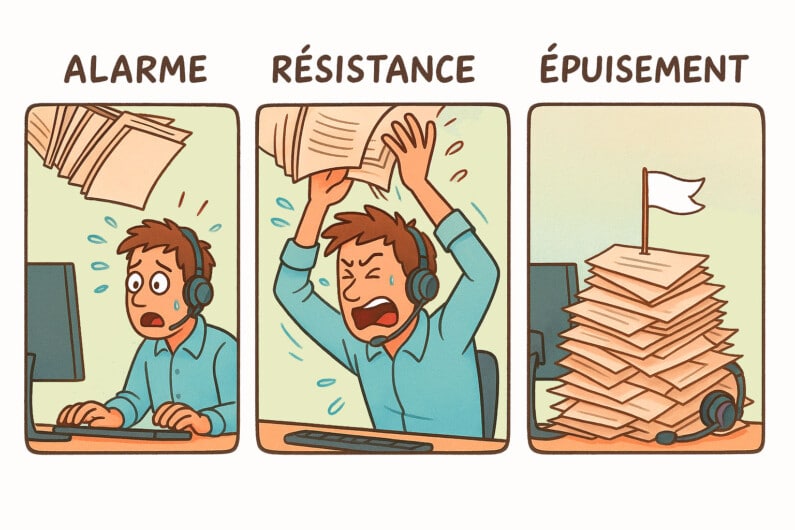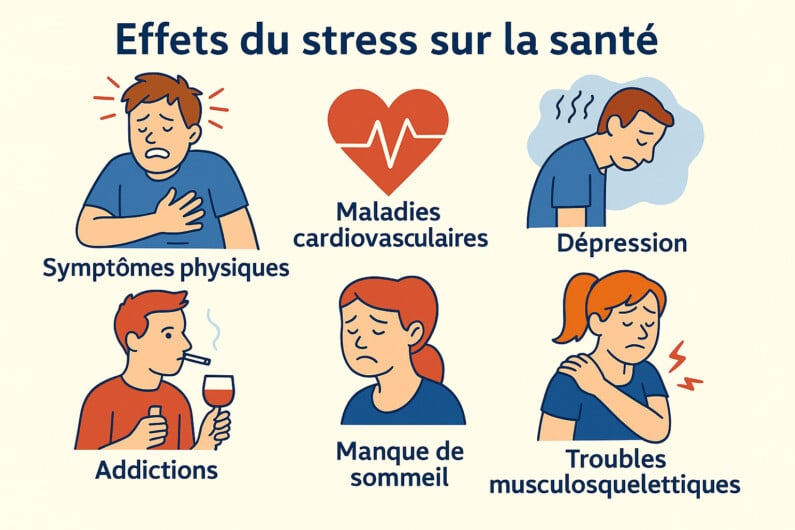IT teams live under constant stress: urgent incidents, continuous alerts, technical debt, ticket overload... This chronic stress is detrimental to both their efficiency and their health. How can you help them take a breather without compromising performance? Here are 10 practical solutions to restore performance and peace of mind.

The world of IT is a dynamic and stimulating field, but it's also one of the most challenging. major source of stress for its professionals.
Between emergency interventions, the constant succession of alerts, the growing technical debt and the avalanche of false positivesThe health of IT teams is being severely tested.
This situation is alarming, particularly in the cyber security A 2024 study by CESIN, an association of IT security managers, revealed that 50 % of cyber managers are under constant stressand 25 % to intense stress.
Stress levels of IT professionals
(inspired by the Holmes-Rahe scale)
Such high levels of stress quickly lead to burn-out.
If we look at all the employees in the tech sector, the developers, technical support and system administrators, 67 % of tech employees have experienced an episode of burn-out, according to a survey conducted in 2023.
To understand these levels of stress and work-related fatigue, it's essential to go back to their origins.

Why are IT teams under pressure?
Stress in the IT sector is fuelled by a number of factors inherent in the very nature of the work.
Short deadlines and high workloads
IT professionals are under constant pressure to deliver quickly, with strict deadlines and an often excessive workload.
In 2023, a survey revealed that 67 % of tech employees have experienced burnoutThis is mainly due to the workload and tight deadlines.
Besides, 57 % of cybersecurity professionals report excessive workloads as a source of stress.
98 % of safety managers say they work an average of nine hours more than their planned hours in their contract, and 15 % work more than 16 hours overtime a week.
Testimonial
"What was the cause was above all the deadline stress. You have to give something back to the customer and it has to work. Sometimes, I think, in certain situations, you find it hard to put what you're doing into perspective and you get overwhelmed by the fact that I have to deliver this thing by such and such a time. So you start to work harder, harder, harder just to achieve the objective".
S., CIO
Complexity and rapid technological change
The frenetic pace of innovation forces IT teams to constantly update their knowledge. This can lead to a feeling of being overwhelmed and insecure.
A ZDNet study showed that 64 % of IT workers feel pressure to constantly update their skills. The complexity of the projects is comparable to a huge jigsaw puzzle without instructions, adding another layer of difficulty.
Increased responsibility and emergencies
IT professionals are often on the front line when it comes to cyber attacks and data breaches, with responsibility for the security of company systems and data.
Constant interruptions due to urgent breakdown requests divert attention and increase stress.
A cyber attack, for example, can cause deep psychological trauma and a period of intense exhaustion for IT teams.
Jérôme Poggi, CISO of the city of Marseillewas one of the first to experience this after the cyber-attack on the city in 2020:
"For six months, I was an aggressive zombie, completely absorbed in rebuilding the SI. No psychological support. Just stress and exhaustion".
He adds: "Even five years later, as soon as an incident occurs, the pulse races, the traumatic memory returns".
Technical debt and obsolete tools
Using outdated or non-intuitive technology platforms, and having to perform tasks manually, can lead to frustration and stress.
Almost a third of IT professionals (38 %) say that technological complexity is a barrier to efficient IT operations.
Data and organisational silos are also a problem, with 55 % of IT professionals reporting partitioned dataThis increases security response times for 62 % IT teams.
Lack of recognition
The feeling that hard work and achievements go unrecognised can be demotivating and increase stress.
F., a software engineer, has experienced this loss of motivation :
"If you want to earn more money and take on more responsibility, you become a manager, but some people don't like that or don't do it well. As a result, more and more pressure is put on developers to meet deadlines. It's a stressful job, because what comes up most are bugs, and therefore mistakes. There are very few good things that come out. The bad things come back more than the good things. It's hard to feel that you're doing a good job".
Information overload
The need to juggle numerous accounts and applications, and the difficulty of finding the most up-to-date information, are sources of stress and digital fatigue.
According to an OpenText study, 40 % of French employees report stress linked to poor information management. Almost six out of ten (57 %) use at least six different accounts, resources and applications every day.
What's more, 47 % of French employees spend an hour or more each day looking for information internally.
Consequences of stress

Excessive stress can lead to burn-outThis can lead to a drop in productivity, a high turnover rate and physical and mental health problems.
F., software engineer, describes the physical and emotional signs of his burn-out:
"I'd fall asleep at my desk in the afternoon, cry over nothing and lose control of everything.
A study by Haystack Analytics revealed that 83 % of software developers suffer from burnout.
S., IT Director, reports that a colleague, suffering from burnout, was no longer physically able to walk through the door of the company:
"And in fact, it was one of the signs of burn-out: the blockagewhen you physically can't get through the door and into the world of work".
The under-35s are more likely to turnover after a cyber attack for fear of being associated with the 'hacked' company.
Chronic stress at work can lead to 50 % increase in the probability of absenteeism.

10 ways to relieve the pressure
Here are some key strategies for transforming stress into a motivating factor and ensuring the well-being of your teams.
1. Promoting a healthy work-life balance
Encourage employees to take days off and holidays, and ensure that they switch off outside working hours. Setting clear limits is essential to avoid burnout. According to a Gallup study, 76 % of tech employees feel overwhelmed by their responsibilities outside work.
Implement flexible working policies, including teleworking and flexible working hours, which can increase employee satisfaction and reduce pressure. For 83 % of IT professionals, flexible working is very important/essential. Companies offering teleworking report a 25 % increase in employee satisfaction.
2. Offering training opportunities and of change
Help your teams to master new technologies and skills by offering training. This boosts their confidence and reduces the stress associated with feeling overwhelmed. 94 % of employees stay longer with a company that invests in their learning. However, there are disparities : 30 % of cyber security professionals have not taken any training at all last year.
3. Encouraging open communication and a supportive culture
Create an environment where team members can express themselves freely about their stress levels and the problems they encounter. Regular one-to-one meetings can encourage these conversations. A culture of openness and support can reduce stress and improve collaboration. One study showed that 52 % of IT workers suffer stress due to communication breakdowns within their teams.
4. Implement stress reduction practices
Incorporate activities such as yoga, meditation or simple stretching routines into the working day. Encourage regular breaks to recharge minds and improve concentration. A study by the University of Illinois found that short breaks can improve concentration and performance.
Regular physical activity is crucial: the CDC notes that it can reduce anxiety by 20 to 40 %. Daily meditation can improve the concentration of 30 %.
5. Recognising and rewarding work
Show appreciation for your team's efforts and achievements. This can be done through recognition programmes or team-building activities, which increase job satisfaction and motivation, thereby reducing stress. One report highlighted that the lack of recognition can be demoralising after so much stress and effort.
6. Providing access to mental health resources
Make information on mental health resources available, as mental well-being is just as important as physical health. It is essential to seek professional help if the burden becomes overwhelming. Companies offering such resources can reduce the turnover rate by 40 % and increase employee productivity by 20 %.
7. Optimise technology infrastructure and consider intelligent outsourcing
Assess whether current technological systems make the job easier or more complicated.
Using an obsolete technology platform can be a major source of stress, leading to "frustrating moments". Unnecessary investment in technology is a problem for 58 % IT professionals.
Consider simplifying ITSM processes to reduce inconvenience. For overwhelming technical tasks, Outsourcing or consulting experts can relieve the pressure.
8. Apply time management techniques and agile methodologies
Use project management tools (such as Jira or Trello) and prioritisation techniques (such as the Eisenhower matrix) to improve organisation.
Agile methodologies (Scrum, Kanban) can help manage workloads by breaking projects down into more manageable tasks. The use of project management tools can lead to a 30 % increase in on-time project deliveries.
9. Leveraging AI for repetitive tasks
AI can take on certain repetitive and time-consuming tasks, such as network performance monitoring or basic troubleshooting.
By automating these tasks, AI can significantly reduce the workload and the avalanche of false positives, freeing up IT professionals for more complex and creative tasks.
A survey showed that IT professionals would like to see AI take over network performance monitoring (44 %), basic device troubleshooting (42 %) and basic IT problem solving (40 %). However, the adoption of AI is often disorganised, with 46 % of employees using AI tools not provided by their employer.
10. Creating a positive and ergonomic working environment
A comfortable, ergonomic workspace, with adequate lighting and controlled noise levels, can improve well-being and concentration.
A study has shown that noise can reduce the performance of 66 %and 60 % of IT workers reported discomfort due to inadequate workstation design.
Clear and transparent communication within teams is comparable to using a connected headset in a team game. It is essential to avoid misunderstandings and strengthen cohesion.
Testimonial
"Burn-out is a strong warning signal about working conditions in the company. That's why we need to start by identify the factors that make the working environment negative asking the whole team for its opinion ".
S., CIO
By implementing these strategies, businesses can create a healthier and more productive working environment for their IT teams. Adopting a holistic approach that puts people at the centre, while optimising processes and tools, will enable IT professionals to transform stress into a motivating force, ensuring their well-being and their passion for innovation.




